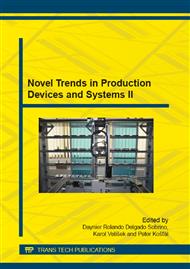[1]
R. Mendřický, Use of Optical Methods for Dimensional Analysis of Multi-Part Moulds. In. Applied Mechanics and Materials, Vol. 474 (2014), Trans Tech Publications, Switzerland, p.387–392.
DOI: 10.4028/www.scientific.net/amm.474.387
Google Scholar
[2]
J. Šafka and P. Keller, Practical Experiences With Sandvik Coroturn HP Tool. University Review Vol. 4, No. 2. Trenčín: Alexander Dubček University of Trenčín, 2010, p.33–37.
DOI: 10.22462/10.12.2019.12
Google Scholar
[3]
P. Keller, K. Drátovník, Porovnání možností a efektivity výroby prototypů na KVS. In. Proceedings of 7th Annual International Conference 2013 Manufacturing Systems Today and Tomorrow, Liberec: TU v Liberci/KVS (2013).
Google Scholar
[4]
M. Matějka, Finančně štíhlá výroba – restrukturalizace výrobního systému podle ROI. In: Výrobní systémy dnes a zítra, Liberec: Technická univerzita v Liberci, (2008).
Google Scholar
[5]
J. Košturiak and Z. Frolík, Štíhlý a inovativní podnik. 1. vyd. Praha: Alfa Publishing, (2006).
Google Scholar
[6]
V. Pelantová, Knowledge Waste in Organisations. In: Periodica Academia. Vol. VIII, Issue 1, 2013, p.57–62.
Google Scholar
[7]
E. Šlaichová and K. Maršíková, The Effect of Implementing a Maintenance Information System on the Efficiency of Production Facilities Journal of Competitiveness Vol. 5, Issue 3, p.60–75, September (2013).
Google Scholar
[8]
P. Ficová and M. Kuncová, Looking for the equilibrium of the shields production system via simulation model. In. 12th International Conference on Modeling and Applied Simulation, MAS 2013, Held at the International Multidisciplinary Modeling and Simulation Multiconference, I3M 2013, pp.50-56.
Google Scholar
[9]
E. Šlaichová, Application of Queueing Theory in Setting Standards of Auxiliary and Service Work. In: Proceedings of the 9th International Conference Liberec Economic Forum 2009. 1. vyd. Liberec: Technical University of Liberec, 2009. s. 364–369.
DOI: 10.14502/tekstilec2018.61.179-191
Google Scholar
[10]
L. Turčok, Optimalizace procesů. In: Modelování, simulace a optimalizace podnikových procesů v praxi. Sborník z konference. Zlín: Univerzita Tomáše Bati, Fakulta managementu a ekonomiky, Ústav průmyslového inženýrství a informačních systémů, 2011, s. 469–473.
Google Scholar
[11]
P. Kopeček, Selected heuristic methods used in industrial engineering, Procedia Engineering 69 (2014) pp.622-629.
DOI: 10.1016/j.proeng.2014.03.035
Google Scholar
[12]
Koblasa, F., Dias, L. S., Oliveira, J. A. and Pereira, G.: Heuristic Approach as a way to Improve Scheduling in ERP/APS Systems. In: Proceedings of 15th European Concurrent Engineering Conference (ECEC2008). Eds. A. Brito and J.M. Teixeira, Porto. EUROSIS-ETI Publication, 2008. 47–51.
Google Scholar
[13]
Koblasa, F., Manlig, F. and Vavruška, J.: Evolution algorithm for job shop scheduling problem constrained by the optimization timespan, Applied Mechanics and Materials, vol. 309, 2013, 350–357.
DOI: 10.4028/www.scientific.net/amm.309.350
Google Scholar
[14]
Daynier Rolando Delgado Sobrino, Peter Košťál and Jan Vavruška: On the Analysis and Customization of an Icim 3000 System: a Take on the Material Flow, Its Complexity and a Few General Issues to Improve. Applied Mechanics and Materials Vol. 474 (2014).
DOI: 10.4028/www.scientific.net/amm.474.42
Google Scholar
[15]
D. Malindžák, Modely a simulácia v logistike, Acta Montanistica Slovaca. 15 (2010) mimoriadne číslo 1, 82–89.
Google Scholar
[16]
V. Votava, Z. Ulrych and M. Edl, Analysis and optimization of complex small-lot production in new manufacturing facilities based on discrete simulation, in: EMSS 2008: 20th European Modeling and Simulation Symposium, 2008, p.198–203.
Google Scholar
[17]
Edl, M.: Využití virtuální reality a diskrétní simulace v řízení výrobních procesů strojírenských podniků v distribuovaném prostředí na základě standardu Higt Level Architecture. Disertační práce. Plzeň: ZČU v Plzni, (2004).
Google Scholar
[18]
P. Raška and Z. Ulrych, Testing optimization methods on discrete event simulation models and testing functions, Procedia Engineering 69 (2014) p.768–77.
DOI: 10.1016/j.proeng.2014.03.053
Google Scholar
[19]
F. Manlig, R. Havlík and A. Gottwaldová, Settings, experimentation and evaluation of the simulation models, Applied Mechanics and Materials. 309 (2013) 366–371.
DOI: 10.4028/www.scientific.net/amm.309.366
Google Scholar
[20]
A. Mahfouz, S. A. Hassan and A. Arisha, Practical simulation application: Evaluation of process kontrol parameters in Twisted-Pair Cables manufacturing systém, Simulation Modelling Practice and Tudory. 18 (2010) 471–482.
DOI: 10.1016/j.simpat.2009.12.008
Google Scholar
[21]
I. Mezgár, Cs. Egresits and L. Monostori, Design and real-time reconfiguration of rébusy manufacturing systems by using design of experiments and artificial neural network, Computers in Industry. 33 (1997) 61–70.
DOI: 10.1016/s0166-3615(97)00011-0
Google Scholar
[22]
B. Can, C. Heavey, Comparison of experimental designs for simulation-based symbolic regression of manufacturing systeme, Computers & Industrial Engineering. 61 (2011) 447–462.
DOI: 10.1016/j.cie.2011.03.012
Google Scholar
[23]
SC&C a partner, Lean Six Sigma workbook, (2011).
Google Scholar


